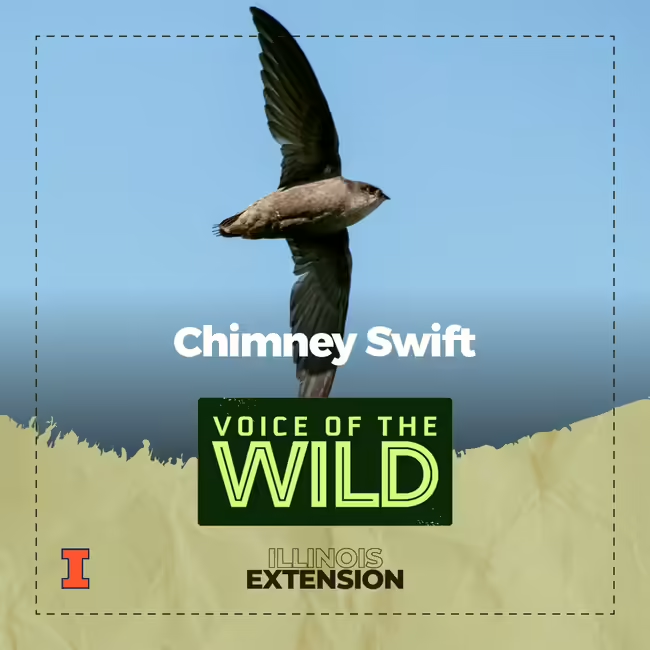
Episode Number
65
Episode Show Notes / Description
Chimney Swift (Chaetura pelagica).
The insectivore that skitters across the summer sky.
Do you want to learn more bird songs, frog calls, and insect noises? Join Voice of the Wild every Friday to explore a new wild voice. We’re available on most podcast platforms, including Apple Podcasts, Spotify, and YouTube.
- Subscription links Here
- Subscribe to the Newsletter
- Listen online on our Homepage
The following Cornell Lab | Macaulay Library recordings were used in this episode:
- Chimney Swift calls by Wil Hershberger (ML507186)
- Chimney Swift young calls by George B. Reynard (ML507188)
Sources and more:
- https://www.allaboutbirds.org/guide/Chimney_Swift
- https://www.audubon.org/field-guide/bird/chimney-swift
- Sibley, D. (2016). Sibley birds East: Field guide to birds of eastern North America (2nd ed.). Alfred A. Knopf.
Transcript
This is Brodie with Illinois Extension and I’m here with a new “voice of the wild”
Though evolved to nest in burnt snags and hollow trees, this insectivorous bird is now highly commensal with humanity, using the walls of our old, uncovered chimneys as a place to roost or build their narrow saucer-like nest, and the daytime and afternoon skies of our cities as a place to forage for flying insects. This is the chimney swift.
You won’t find the chimney swift perched in a tree…. or perched anywhere; their diminutive legs are suitable only for clinging to vertical surfaces, but once aloft they’re an agile bird and their shallow, stiff wingbeats send them Skittering across the sky like water in a hot pan. As fall approaches, keep an eye on large chimneys around dusk wherever there are lots of chimney swifts foraging; with a little luck, you’ll find their nighttime roost that many hundreds will spiral into as the day turns to night. Here's the chimney swift again
Thank you to the Macaulay library at the Cornell lab for today’s sound. Learn more about voice of the wild at go.illinois.edu/VOW
Though evolved to nest in burnt snags and hollow trees, this insectivorous bird is now highly commensal with humanity, using the walls of our old, uncovered chimneys as a place to roost or build their narrow saucer-like nest, and the daytime and afternoon skies of our cities as a place to forage for flying insects. This is the chimney swift.
You won’t find the chimney swift perched in a tree…. or perched anywhere; their diminutive legs are suitable only for clinging to vertical surfaces, but once aloft they’re an agile bird and their shallow, stiff wingbeats send them Skittering across the sky like water in a hot pan. As fall approaches, keep an eye on large chimneys around dusk wherever there are lots of chimney swifts foraging; with a little luck, you’ll find their nighttime roost that many hundreds will spiral into as the day turns to night. Here's the chimney swift again
Thank you to the Macaulay library at the Cornell lab for today’s sound. Learn more about voice of the wild at go.illinois.edu/VOW